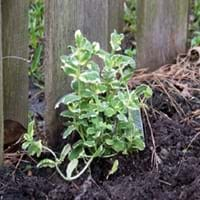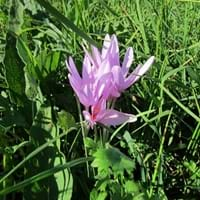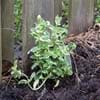Life Span
Perennial
Perennial
Type
Herbs
Bulb or Corm or Tuber
Origin
Southern Europe
Europe, Turkey, Central Asia, Western Asia
Types
Not Available
Colchicum cupanii, Colchicum alpinum
Habitat
Cultivated Beds, Dappled Shade, Shady Edge, Sunny Edge, Woodland Garden
Fields, meadows, Rocky areas, Shaded sites, Woodlands
USDA Hardiness Zone
6-9
Not Available
AHS Heat Zone
9-5
Not Available
Sunset Zone
4, 5, 6, 7, 8, 9, 10, 11, 12, 13, 14, 16, 17, 18, 19, 20, 21, 22, 23, 24
21,22
Habit
Spreading
Clump-Forming
Minimum Width
Not Available
Flower Color
White, Pink
White, Yellow, Purple, Violet
Flower Color Modifier
Bicolor
Bicolor
Fruit Color
Brown
Not Available
Leaf Color in Spring
White, Light Green
Green
Leaf Color in Summer
White, Light Green
Light Green
Leaf Color in Fall
White, Light Green
Several shades of Green
Leaf Color in Winter
Light Green
Light Green
Leaf Shape
Oval
Long Linear
Plant Season
Spring, Summer, Fall
Spring, Fall, Winter
Sunlight
Partial Sun, Partial shade
Full Sun, Partial Sun
Type of Soil
Clay, Loam, Sand
Loam
The pH of Soil
Acidic, Neutral
Acidic, Neutral
Soil Drainage
Poorly Drained
Well drained
Bloom Time
Summer
Early Spring, Late Summer, Early Fall, Fall, Late Fall, Winter, Late Winter
Tolerances
Drought
Drought
Where to Plant?
Container, Ground, Pot
Container, Ground, Pot
How to Plant?
By dividing rhizomes, tubers, Stem Cutting
Divison, Seedlings
Plant Maintenance
Medium
Low
Watering Requirements
Average Water Needs, Do Not over Water, Requires regular watering
Do Not over Water, Medium, Needs less watering, Never Over-water, Requires regular watering, Water less during winter
In Summer
Lots of watering
Ample Water
In Spring
Moderate
Less Watering
In Winter
Average Water
Less Watering
Soil pH
Acidic, Neutral
Acidic, Neutral
Soil Type
Clay, Loam, Sand
Loam
Soil Drainage Capacity
Poorly Drained
Well drained
Sun Exposure
Partial Sun, Partial shade
Full Sun, Partial Sun
Pruning
Prune in the growing season, Remove damaged leaves, Remove dead branches, Remove dead leaves
Remove damaged leaves, Remove dead leaves, Remove dead or diseased plant parts, Remove shoots
Fertilizers
All-Purpose Liquid Fertilizer, Fertilize in early spring
fertilize in growing season, Less fertilizing
Pests and Diseases
Red blotch
Not Available
Plant Tolerance
Drought
Drought
Flower Petal Number
Single
Single, Double
Fragrant Bark/Stem
Yes
No
Foliage Texture
Medium
Coarse
Foliage Sheen
Matte
Not Available
Attracts
Bees, Butterflies, pollinators
Bees, Butterflies
Allergy
Itchiness, Skin rash, Stomach pain, Swelling
Kidney Disease, Low blood pressure, Stomach pain, Toxic, Vomiting
Aesthetic Uses
Bonsai, Showy Purposes
Landscape Designing
Beauty Benefits
Good for skin
Not Available
Environmental Uses
Air purification
Air purification, No fertilizer, pesticides, or herbicides needed, Prevent Soil Erosion
Medicinal Uses
Antiseptic, Digestive disorders, Fever, Headache
anti-cancer, anti-inflammatory, Diarrhea, Diuretic, Rheumatism
Part of Plant Used
Fruits, Leaves
Flowers, Leaves
Other Uses
Added to salads, Used as essential oil, Used in making tea, Used to make herbal teas
Employed in herbal medicine, Showy Purposes, Used as Ornamental plant, Used for its medicinal properties
Used As Indoor Plant
Yes
Yes
Used As Outdoor Plant
Yes
Yes
Garden Design
Bog Garden, Edible, Groundcover, Herb / Vegetable
Alpine, Container, Cutflower, Foundation, Lawns and Turf, Mixed Border, Rock Garden / Wall, Wildflower
Botanical Name
MENTHA suaveolens 'Variegata'
COLCHICUM
Common Name
Applemint, Variegated Applemint
Colchicum
In Hindi
Applemint Tree
colchicum
In German
Applemint Baum
colchicum
In French
Applemint Arbre
colchique
In Spanish
Árbol Applemint
Colchicum
In Greek
Applemint Δέντρο
Colchicum
In Portuguese
Árvore applemint
Colchicum
In Polish
Applemint Drzewo
Colchicum
In Latin
Applemint ligno
Colchicum
Phylum
Magnoliophyta
Magnoliophyta
Class
Magnoliopsida
Liliopsida
Family
Lamiaceae
Liliaceae
Clade
Angiosperms, Asterids, Eudicots
Angiosperms, Monocots
Tribe
Mentheae
Not Available
Subfamily
Faboideae
Wurmbaeiodeae
Number of Species
Not Available
Importance of Applemint and Colchicum
Want to have the most appropriate plant for your garden? You might want to know the importance of Applemint and Colchicum. Basically, these two plants vary in many aspects. Compare Applemint and Colchicum as they differ in many characteristics such as their life, care, benefits, facts, etc. Every gardener must at least have the slightest clue about the plants he wants to plant in his garden. Compare their benefits, which differ in many ways like facts and uses. The medicinal use of Applemint is Antiseptic, Digestive disorders, Fever and Headache whereas of Colchicum is anti-cancer, anti-inflammatory, Diarrhea, Diuretic and Rheumatism. Applemint has beauty benefits as follows: Good for skin while Colchicum has beauty benefits as follows: Good for skin.
Compare Facts of Applemint vs Colchicum
How to choose the best garden plant for your garden depending upon its facts? Here garden plant comparison will help you to solve this query. Compare the facts of Applemint vs Colchicum and know which one to choose. As garden plants have benefits and other uses, allergy is also a major drawback of plants for some people. Allergic reactions of Applemint are Itchiness, Skin rash, Stomach pain and Swelling whereas of Colchicum have Kidney Disease, Low blood pressure, Stomach pain, Toxic and Vomiting respectively. Having a fruit bearing plant in your garden can be a plus point of your garden. Applemint has no showy fruits and Colchicum has no showy fruits. Also Applemint is flowering and Colchicum is not flowering . You can compare Applemint and Colchicum facts and facts of other plants too.





